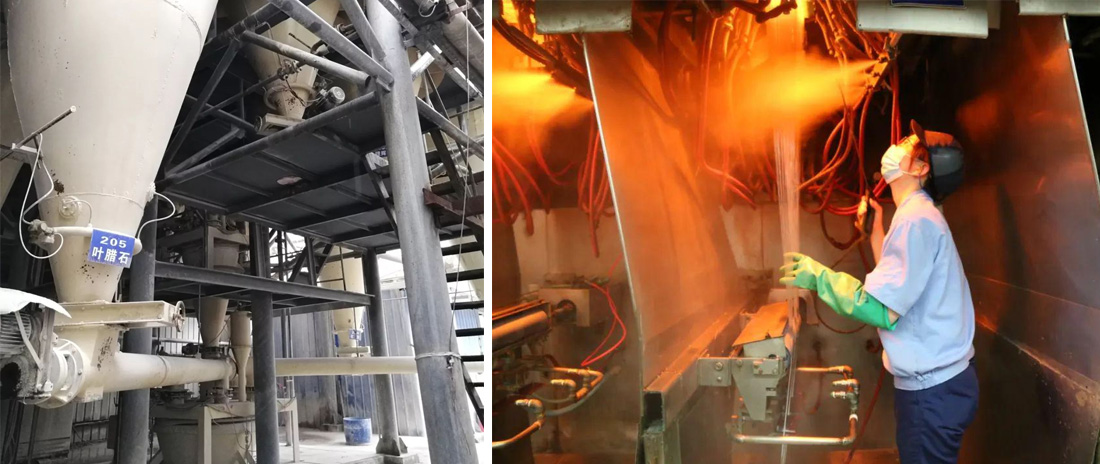Bubbling, a critical and widely used technique in forced homogenization, significantly and complexly impacts the fining and homogenization processes of molten glass. Here is a detailed analysis.
1. Principle of Bubbling Technology
Bubbling involves installing multiple rows of bubblers (nozzles) at the bottom of the melting furnace (typically in the latter part of the melting zone or the fining zone). A specific gas, usually compressed air, nitrogen, or an inert gas, is injected into the high-temperature molten glass in a periodic or continuous manner. The gas expands and rises through the molten glass, creating columns of rising bubbles.
2. Impact of Bubbling on the Fining Process (Primarily Positive)
Bubbling mainly helps remove gas bubbles, thereby clarifying the glass.
Promoting Bubble Removal
Suction Effect: A low-pressure zone forms in the wake of the large, rising bubbles, creating a “pumping effect.” This efficiently draws in, gathers, and merges tiny micro-bubbles from the surrounding molten glass, carrying them to the surface for expulsion.
Reduced Gas Solubility: The injected gas, especially inert gas, can dilute the dissolved gases in the molten glass (e.g., SO₂, O₂, CO₂), reducing their partial pressure. This facilitates the exsolution of dissolved gases into the rising bubbles.
Reduced Local Supersaturation: The rising bubbles provide a ready-made gas-liquid interface, making it easier for supersaturated dissolved gases to exsolve and diffuse into the bubbles.
Shortened Fining Path: The rising bubble columns act as “fast tracks,” accelerating the migration of dissolved gases and micro-bubbles toward the surface.
Foam Layer Disruption: Near the surface, rising bubbles help break up the dense foam layer that can impede gas expulsion.
Potential Negative Effects (Require Control)
Introduction of New Bubbles: If bubbling parameters (gas pressure, frequency, and purity) are improperly controlled or if nozzles are blocked, the process can introduce unwanted new, small bubbles. If these bubbles can’t be removed or dissolved in subsequent fining, they become defects.
Improper Gas Selection: If the injected gas reacts unfavorably with the molten glass or dissolved gases, it could produce more difficult-to-remove gases or compounds, hindering the fining process.
3. Impact of Bubbling on the Homogenization Process (Primarily Positive)
Bubbling significantly enhances the mixing and homogenization of the molten glass.
Enhanced Convection and Agitation
Vertical Circulation: As the bubble columns rise, their low density compared to the molten glass creates a strong upward flow. To replenish the rising glass, the surrounding and bottom glass flows horizontally toward the bubble column, creating a powerful vertical circulation or convection. This forced convection greatly accelerates the horizontal mixing of the molten glass.
Shear Mixing: The velocity difference between the rising bubbles and the surrounding molten glass generates shear forces, promoting diffusive mixing between adjacent layers of glass.
Interface Renewal: The agitation from the rising bubbles continuously refreshes the contact interfaces between glass of different compositions, improving the efficiency of molecular diffusion.
Disruption of Stratification and Striations
Strong convection effectively breaks up chemical or thermal stratification and striations caused by density differences, temperature gradients, or uneven feeding. It incorporates these layers into the main flow for mixing.
This is especially helpful in eliminating “dead zones” at the bottom of the tank, reducing crystallization or severe inhomogeneity caused by prolonged stagnation.
Improved Homogenization Efficiency
Compared to natural convection or temperature-gradient flows, the forced convection generated by bubbling has a higher energy density and wider reach. This significantly shortens the time required to achieve a desired level of homogeneity or achieves higher uniformity within the same timeframe.
Potential Negative Effects (Require Attention)
Refractory Material Erosion: The high-speed flow of rising bubbles and the intense convection they induce can cause stronger erosion and corrosion of the tank bottom and side-wall refractory materials, shortening the furnace’s lifespan. This can also introduce erosion products into the molten glass, creating new sources of inhomogeneity (stones, striations).
Disruption of Flow Patterns: If the bubbling point layout, bubble size, or frequency are poorly designed, they can interfere with the original, beneficial temperature and natural flow fields within the melting tank. This could create new inhomogeneous regions or vortices.
4. Key Control Parameters for Bubbling Technology
Bubbling Position: Typically in the latter part of the melting zone (ensuring raw materials are mostly melted) and the fining zone. The position must be chosen to optimize the flow and temperature fields.
Gas Selection: Options include air (low cost, but strong oxidizing properties), nitrogen (inert), and inert gases like argon (best inertness, but expensive). The choice depends on the glass composition, redox state, and cost.
Bubble Size: The ideal is to produce larger bubbles (several millimeters to centimeters in diameter). Small bubbles rise slowly, have a weak suction effect, and may not be easily expelled, becoming defects. Bubble size is controlled by nozzle design and gas pressure.
Bubbling Frequency: Periodic bubbling (e.g., once every few minutes) is often more effective than continuous bubbling. It creates strong disturbances while allowing time for bubbles to be expelled and the glass to stabilize. The intensity (gas flow rate and pressure) must be matched to the glass depth and viscosity.
Bubbling Point Layout: Arranging multiple rows in a staggered pattern that covers the entire width of the tank ensures convection reaches all corners, preventing “dead zones.” The spacing needs to be optimized.
Gas Purity: Impurities like moisture or other gases must be avoided to prevent new problems.
In conclusion, bubbling is a crucial technology that injects gas into molten glass to create strong vertical circulation and agitation. This not only significantly accelerates the internal fining process, helping small and large bubbles merge and be expelled, but also effectively breaks up chemical and thermal inhomogeneous layers and eliminates flow dead zones. Consequently, it greatly improves the homogenization efficiency and quality of the glass. However, strict control over key parameters such as gas selection, position, frequency, and bubble size is essential to avoid introducing new bubble defects, worsening refractory erosion, or disrupting the original flow field. Therefore, while it has potential drawbacks, bubbling is a key technology that can be optimized to significantly enhance glass manufacturing.
Post time: Aug-21-2025







